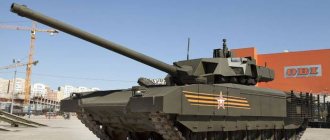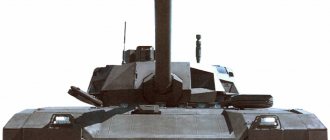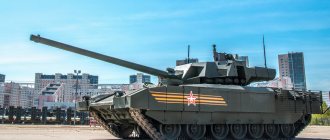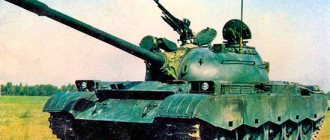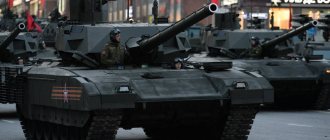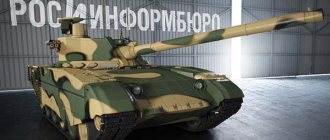New tank of Russia: general information
Tank "Armata" T-14
will be a real highlight at the celebration of the 70th anniversary of the victory over Nazi Germany.
Thus, about two hundred units of military equipment and 16,500 military personnel will be involved in the parade, which will take place on May 9 on Red Square. The production of tanks is carried out by JSC NPK Uralvagonzavod.
Interesting Facts!
In April, the Russian Ministry of Defense lifted the veil of secrecy and showed photographs of the innovative tank, only its turret was covered with fabric, so only its platform could be seen.
Today you can see the Armata T-14 tank on the website of the Russian Ministry of Defense, where other types of new armored vehicles are presented. The tank arrived at the dress rehearsal completely open.
Mass production of a new Russian tank
As part of a large-scale rearmament program, it is planned to produce 2 300
T-14 tanks, with the start of operation of this vehicle scheduled for 2016.
Thanks to this number of new tanks, the Russian ground forces will replace all the outdated tanks that remain from Soviet times.
But what is the peculiarity
tank "Armata" T-14?
Uninhabited tower
The main feature of this unique combat vehicle is its uninhabited turret.
. Thus, the tank’s crew, consisting of three people, is located in a separate capsule, while the gun is controlled remotely.
Stealth developments
Stealth technologies have long been used in the creation of military equipment. Their main purpose is to make the vehicle as invisible as possible to the enemy. Similar technologies were used in the design of the Armata tank. Russian weapons are famous not only for their firepower, but also for their invulnerability to the enemy, and the stealth technologies used in the T-14 tanks are implemented through the following developments:
- The reflective edges of the tank's hull make it "invisible" to radar in any applicable range. This special coating prevents the case from heating up from sunlight.
- The tank's thermal traps distort the picture when irradiated by radars operating in the infrared wavelength range. The thermal insulation of the housing also plays a significant role.
- The casing placed on the tower serves as an additional obstacle to radars.
- There is protection against magnetometric weapons. It distorts the magnetic field around the car.
- A system that mixes exhaust gases with the surrounding air, as well as false exhaust pipes, disorient the enemy observing the tank using a thermal range device.
Technical characteristics of the Armata T-14 tank
But on the uninhabited turret the innovations of the T-14 Armata tank
don't end.
A gun
Smoothbore 125 mm gun
produces fire not only with conventional projectiles, but also
with guided missiles.
The gun's ammunition capacity is 45 rounds, with an automatic loader
– 32 shells. The tank's rate of fire is 10 -12 rounds per minute.
Ammunition
located in a special module, which significantly increases the “survivability” of the tank. And all thanks to the fact that the possibility of detonation of ammunition when a projectile hits the vehicle body is eliminated.
Important!
"Armata" can fire the following types of projectiles:
- high-explosive fragmentation
- surface-to-air missiles
- armor-piercing sub-caliber
- surface-to-surface missiles
- cumulative.
Machine gun
The Armata tank is equipped with a twin (two-barrel) 7,62
-
a millimeter machine gun
located outside the turret (machine gun ammunition capacity is 1000 rounds, with the same number of rounds stored in belts at the rear of the turret).
The tank is equipped with an additional installation with a 12.7 mm machine gun
called “Kord”, which is installed together with the commander’s panorama (the machine gun’s ammunition capacity is 300 rounds in the belt itself, and the same number of rounds is stored in the spare parts box directly at the rear of the turret).
Electronic systems
The tank is equipped with electronic systems
that collect and analyze tactical data from various sources. The presence of new electronics can significantly reduce the time between detecting a target and directly hitting it.
“reaction time” has been reduced on the Armata tank
from 5 - 6 seconds to 3 - 4 seconds, like German and American cars.
target hitting range has also been improved.
, which at “Armata” is more than
3.5 km.
For comparison: for outdated Russian tanks this parameter did not exceed 2.5 km, while for modern American and German vehicles it is 3 – 3.5 km.
Platform
Interesting fact!
According to the design concept, the Armata platform can be used
for other combat vehicles,
for example, an infantry fighting vehicle or a self-propelled artillery unit. This will help reduce the cost of manufacturing the listed types of combat vehicles, as well as simplify their maintenance and repair.
The tank platform is presented in two versions:
- chassis with a front-mounted engine compartment (or PMTO)
- chassis with a rear engine-transmission compartment (or RMT).
Armor
The tank's armor can withstand hits from anti-tank missiles, while active protection helps intercept shells directly on approach to the tank. Armor resistance is more than 900 mm.
Power point
This part of the Armata tank is a powerful diesel engine
at 1500 hp
Engine life of the tank
(the number of hours that the engine can operate without repair) is 2,000 hours.
Installation weight
– about 5 tons.
Additional equipment "Armata" T-14
Among the additional systems of the Armata T-14 tank, the following can be noted:
- air conditioner
- aircraft-type radar that can detect dynamic and aerodynamic targets
- night vision system
- new armor that allows the thickness of the hull to be reduced by 15%, which will not affect the protective characteristics of the vehicle in any way
- protection against weapons of so-called mass destruction
- IUS chassis (or “digital board”), with the help of which it will be possible to implement launching, control, as well as diagnosing and adjusting the machine
- seven-wheel suspension, which is controlled using vane shock absorbers;
- 12-speed automatic transmission (manual shift possible)
- digital control systems that simplify and speed up the operation of the tank.
O, whose mass is about 50 tons,
equipped with a powerful diesel engine.
The car is able to reach a speed of 80 - 90 km/h.
MILITARY REVIEW AND POLITICS
Introduction
The ARMATA tank was developed for a very long time and had many options. Therefore, there were a lot of incredible rumors about him on the Internet and many of the most incredible photographs and diagrams of his appearance were presented.
I RECOMMEND THE ARTICLE - ANASTASIA DYNKINA, THE GIRL WHO SHOWED US EVERYTHING
You can click on the photographs, some of which are enlarged to unprecedented sizes. We were promised an unprecedented amount of weapons and a one hundred and fifty-two millimeter caliber gun. I don’t know what the designers of ARMATA dreamed of, but everything turned out to be much more prosaic and traditional.
First the BLACK EAGLE tank appeared. But if you look closely at the number of undercarriage rollers, it will become clear that this is already an ARMATA but with a manned turret. In the end, an uninhabited weapons compartment was installed on the BLACK EAGLE and the result was the T-14 ARMATA tank.
LAYOUT OF THE T-14 ARMATA TANK
The control compartment is located in the front part of the body. It carries a crew of three people. Everyone sits side by side in an isolated armored capsule. The driver is on the left, the commander is on the right, the weapons operator (it’s hard to call him simply a gunner) is in the center. The crew seats are tilted back, like in a dentist's office. On the one hand, this is convenient and allows you to reduce the height of the tank’s hull, but on the other hand, there is a danger of falling asleep during the battle. Instead of control levers, the driver has a small steering wheel, like for playing on the Internet, and two pedals - gas and brake. The thickness of the hatch covers immediately draws your attention - this is the first time that a tank has such thick armor on top.
Behind the crew capsule is a fully autonomous weapons compartment. It contains a smoothbore gun of one hundred and twenty-five millimeter caliber, an automatic loader and ammunition. On the roof of the turret there is a 7.62 mm machine gun with remote control. The engine is located at the rear of the hull. In general, the layout is classic. The only novelty is the uninhabited tower.
The tower has a simple rectangular shape, but so much equipment is hung on it that the tower itself is practically invisible, plus all the equipment is covered with a casing on top. The turret contains only the automatic loader and ammunition, so the barrel purging ejector was removed from the gun. Under the tower there are launch tubes containing combat elements that should destroy incoming shells and missiles. The entire tank and especially the turret are covered with locators, cameras, and sensors. In my article WILL TANKS SHARE THE FATE OF BATTLESHIPS, I predicted that the tanks of the future will receive a full-fledged system of protection against everything in the world and will become abnormally expensive. All my predictions are coming true. Fourteen T-14 tanks have been ordered for this year. That is, one tank and one road wheel per month. In the photo: Number one is the tank commander's hatch. I have already noticed that this is the first time that the top armor of a tank has such a thickness. Number two shows launch containers for combat elements that should hit incoming shells and anti-tank missiles. Directly above them is a passive phased array antenna (antenna) of the locator. It is he who tracks incoming anti-tank ammunition and controls the shooting of combat elements to destroy them. There are two antennas in total, on both sides of the tower. Number three shows the active phased array antenna of the surveillance radar. There are only four of them, which provides all-round visibility. The entire passive defense system, including antennas and launchers with curtain grenades, is also marked in yellow.
This photo shows the locator antenna which is located on the rear side of the tower on the right. It is grayer in color than the tower. Next to him is an infrared camera facing backwards. Such cameras are located on all four sides of the tower near the all-round antennas. But let's return to the previous photo. Number four is a panoramic sight, mounted on the base along with the machine gun. Number five shows the review cameras, they are directed in all four directions. Moreover, one camera works in the infrared and the other in the ultraviolet range. Number six is the feeding niche. In theory, there should be a loading mechanism there. Not all of it, of course, but apparently a shell rammer.
The same thing but bigger. One is surveillance cameras. Two - surveillance radar antenna installed on the front right. Three - antenna for a tank protection locator from anti-tank missiles and shells. Four is an installation for shooting camouflage grenades.
T-14 ARMATA TANK TOP VIEW One - external fuel tanks. Two - a panoramic sight and a machine gun. Three - a technological hatch for access to the loading mechanism. Five is an installation for shooting camouflage grenades. Six is a mysterious niche, no one really knows what will be installed in it. Seven are blocks of mounted side armor. Eight—the viewing angle of onboard locators is shown.
ENGINE OF TANK T-14 ARMATA
The T-14 tank has a new X-shaped supercharged diesel engine 2V-12-3A with a power of one and a half thousand horsepower. True, it can be called new very conditionally - it has been in development for twenty years. Only earlier it was called A-85-3
Here he is at the exhibition on the far right. Judging by the designation 2B-12-3A, the engine has twelve cylinders, that is, three per block. The piston group was inherited from the famous V-2 diesel engine, which was installed on the T-34. Only the piston stroke of the new engine was reduced and the crankshaft speed was increased. The liter output of the engine decreased, but the power increased due to the increase in rotation speed. Today, the 2V-12-3A engine has very high specific characteristics, at least the stated very high ones. Power one thousand five hundred horsepower. Nowadays, though, power is usually given in kilowatts, but I’m used to horsepower and higher values are obtained. And this with a volume of only thirty-four and a half liters and an engine weight of one and a half tons. In this case, the liter power is a little more than forty-three horsepower per liter. Like the best aviation gasoline engines of the SECOND WORLD WAR. Specific power (horsepower per kilogram of weight) is slightly worse and equal to one, but this is not critical. For a tank, the main thing is the size of the engine - the smaller it is, the lower the hull and, accordingly, less armor is needed to protect it.
The engine is installed in the tank in a single unit with an automatic gearbox and two radiators - they are on top in the photo.
Photo of the rear of the T-14, showing the radiator grilles and additional fuel tanks on the sides of the hull.
The engine exhaust pipes exit on both sides.
As you can see in the top photo, there is a special hole next to the exhaust pipe. through which cold air is supplied to the exhaust area. This reduces thermal radiation and reduces visibility. The engine compression ratio is eleven. The maximum speed is two thousand per minute. After compression, the air enters a special radiator and is cooled there. This allows you to increase the air density at the same pressure and, as a result, supply more oxygen to the engine cylinders. A high compression ratio and high engine speeds lead to high thermal and mechanical loads, so the engine life is likely to be very short. Aviation engines with such liter power indicators had a service life of about one hundred hours. Now the level of production is somewhat different, but I don’t think that the engine life exceeds five hundred hours. Therefore, information is often found that the power of a 2V-12-3A engine in operation, in order to increase its service life, is limited to one thousand three hundred horsepower. With a tank weighing fifty-five tons, the specific power is twenty-seven horses per ton.
CHASSIS OF THE T-1 ARMATA TANK
Here is the T-14 chassis without mounted armor. Seven road wheels. It can be seen that the first two and one last support roller have oil dampers to reduce vibrations. There are four supporting rollers. It is believed that the suspension has a reserve of another fifteen additional tons of weight.
RESERVATION AND PROTECTION OF THE T-14 ARMATA TANK
A small technical digression. Tank armor lost the competition to anti-tank shells back during the SECOND WORLD WAR. The T-34 was defenseless against a caliber of seventy-five millimeters, the Tiger was hit by a caliber of eighty-five millimeters. There was no escape for anyone at all from cumulative shells. And all that the designers could come up with was to protect the frontal projection of the tank and attach dynamic protection. ARMATA is no exception. The frontal projection is protected by multilayer armor, which includes layers of steel and ceramic armor located at a large angle. On top of all this are seven blocks of reactive armor
Ceramic armor has abnormal hardness, but is very fragile, so it can only exist as a layer between metal sheets.
The photo shows a table for comparing the physical characteristics of ceramics and steel.
We are most interested in density (specific gravity), hardness and ductility (fourth column). As you can see, ceramics can be three times lighter than steel, ten times harder, but also ten times more brittle. Reactive armor blocks perfectly dampen the cumulative jet and deflect the cores of sub-caliber projectiles (especially modern ones - long and thin), but this is one-time protection. The hull has relatively thin armor. Why do I think this? Because the famous steel 44S-SV-Sh does not allow the production of sheets of large thickness. Or rather, you can make it, but it won’t do any good.
Judging by its abnormal hardness and fairly average elastic modulus, this armor is designed to withstand armor-piercing projectiles with a high initial velocity, but of low weight. Any large-caliber projectile will simply shatter it. The fact that it is supposedly easy is also nonsense. The letter B in its composition means the presence of tungsten - the material is terribly expensive and abnormally heavy. Additionally, the sides of the hull are protected by fuel tanks, which are located in a casing with fairly thick walls.
Reactive armor blocks are hung on top of all this.
True, they decided to save money here too; the rear part of the body was protected with a regular grille.
Active protection of the T-14 ARMATA tank involves the destruction of anti-tank shells by shooting combat elements towards them. The launch tubes for combat elements are located so that shooting is possible only in two narrow sectors to the left and right of the gun barrel. Therefore, the anti-tank projectile must first detect the surveillance locator, give the command to turn the turret in a dangerous direction, and only then the locator that controls the shooting of combat elements is activated. This scenario is suitable for destroying an anti-tank missile, but will the turret have time to turn towards a sub-caliber projectile that flies at a speed of almost two kilometers per second?
The passive protection of the T-14 ARMATA tank consists of tubular guides for firing masking shells.
As soon as the sensors located on the turret detect radar irradiation or laser illumination, several camouflage ammunition is immediately fired, which creates a cloud of smoke and metal foil particles around the tank. Passive protection also includes a special coating on the hull and turret, which absorbs radio radiation and makes the combat vehicle unnoticeable to the radar. ARMATA is said to have a strong electronic warfare system that can detonate electronically detonated mines and deflect radar-homing missiles.
ARMAMENT OF THE T-14 ARMATA TANK
The armament consists of a remote-controlled machine gun and the most powerful, most wonderful smooth-bore tank gun of one hundred and twenty-five millimeter caliber. A new sub-caliber projectile with a core of extraordinary length was manufactured for the gun. That is, the combat vehicle was designed based on the stupidest variant of combat operations - a counter battle with enemy tanks. And they also tell us that there is a version of a gun with a caliber of one hundred and fifty-two millimeters, although when it is installed, the ammunition is very small, and there are no shells for it in mass production.
OBSERVATION DEVICES FOR TANK T-14 ARMATA
There are only three conventional viewing devices.
Two large ones on the sides of the commander and driver, and one small one for the weapons operator. Naturally, the weapon operator sees the battlefield through a sight mounted on the turret. In addition, surveillance cameras are installed on the tank turret on all sides. This allows for 360-degree surveillance. Each chamber has a tube supplying washing liquid, which allows the chambers to be cleaned of dirt during combat without going outside. In addition, a surveillance locator can be classified as a surveillance system. It can track both ground and air targets within a radius of one hundred kilometers. A small lyrical digression. Now everyone unanimously declares that ARMATA is BETTER than ABRAMS. Guys, there is a thirty year difference between these tanks. Abrams have not been produced for twenty years now.
BEAUTIFUL PHOTOS OF THE T-14 ARMATA TANK
I'm a funny person and I like to make fun of stupid search robots. To see such photos upon request of TANK T-14 ARMATA PHOTO
Armata tank hull
The hull of the Armata tank, which is replete with high-resolution video cameras,
allowing the crew to control the environment. The cameras operate regardless of the time of day and weather conditions.
SAZ (active protection system)
The tank is equipped with an active protection system called “Afganit”,
thanks to which it became possible to counter enemy shells and missiles at a distance not exceeding 20 m.
Simply put, this system is a tank anti-missile and anti-ballistic defense system that protects the combat vehicle from ground and air attacks.
The main purpose of the SAZ is to intercept
not only high-speed kinetic missiles, but also impact cores, the approach speed of which is 2,500 - 3,000 m/s.
Dynamic protection
In addition to active protection, the Armata tank (or rather the turret of the vehicle) is equipped with three dynamic protection units,
which are containers with pre-installed dynamic protection elements separated by layers of filler.
Protection complexes and armor
The protection of the T-14 tank is provided by special protection systems, as well as a special design of the armor of the turret, hull and compartments. It ensures high survivability of the vehicle in combat conditions, protection of the crew and engine from damage by shells and anti-tank guided missiles (ATGM).
Active protection complex "Afganit"
Armor of any design is not capable of guaranteeing complete protection of the vehicle and crew from damage. To increase the protective function, the T-14 tank is equipped with an active protection complex (APS) “Afganit”. Its task is to intercept various ammunition on approach. The functionality of the KAZ is ensured by radio-optical long-range warning radars. They include four dedicated pulse-Doppler panels as well as circular ultraviolet direction finders (UV direction finders). The panels detect the approach of ammunition (including missiles), and direction finders detect flashes when fired from ATGMs.
The operating principle of KAZ is based on several mechanisms:
- Reflecting an attack with the help of striking elements (“shock core”). Under the armor there are shotgun pedestals, which with their elements shoot down ammunition flying at speeds of up to 3 km/s.
- Camouflage using special “guns” placed on the tower roof. They receive a signal from the sensors, and a device is triggered, providing a smoke screen in various spectra (for example, the infrared spectrum), releasing mini-dipoles to disrupt the operation of the radar. Using this system, laser guidance is blocked, including damage from homing ammunition.
- Rotate the tower. Active protection provides for automatic rotation of the turret to position the most armor-protected zone in the direction of the arrival of projectiles.
The use of the Afghanit KAZ involves the combination of early attack detection and fire control systems for a retaliatory strike.
Dynamic protection complex "Malachite"
The second stage of protection for the T-14 tank is the Malachite dynamic armor complex (KDB). It consists of modules mounted on armor, which are detonated remotely when ammunition approaches. The system effectively protects against armor-piercing sub-caliber projectiles and missiles. It is capable of destroying shells with a smaller amount of explosive before they come into contact with the tank’s armor.
The detonation occurs due to a signal from sensors in which a current is induced from the magnetic field of an approaching projectile. The system was developed by the Steel Research Institute and belongs to the 4th generation of protection. In most cases, the KDB is coordinated with the Afganit KAZ, and its radar is capable of sending a signal to preemptively fire the module’s charge.
The Malachite KDB is very effective against Javelin-type ATGMs when the missile approaches at an angle of no more than 65 degrees, and also almost completely (up to 96%) blocks the capabilities of RPGs. It is important to note that the system protects the crew from damage and often saves lives, but the blast wave from the explosion of modules and approaching ammunition can immobilize the vehicle and disable the devices.
Reservation of the turret, hull and compartments
The last barrier to an incoming projectile is armor. The latest technological innovations have been introduced on the T-14 tank, which can significantly increase its efficiency. The armor of the tank's turret is made in the form of two layers - the main armor and the anti-fragmentation casing. Many devices and sensors are located in the interlayer space.
On the outside there is a casing that protects against fragmentation, bullet and high-explosive damage. At the same time, it jams the radar signal, which reduces the effectiveness of radar and homing ATGMs. An additional function of the casing is the role of a “Faraday cage”, which is designed to protect devices from the electromagnetic field. This element has a collapsible design, which simplifies access to the instrument panels.
The main armor of the turret is made of special high-strength armor steel grade 44S-SV-Sh. It was obtained by electroslag remelting. Modern technology has made it possible to reduce the weight of armor by 15% while increasing strength. In terms of armor resistance, it is equivalent to homogeneous armor with a thickness of about 1000 mm when hit by sub-caliber projectiles and about 1600 mm when hit by cumulative ammunition.
The principle of “knockout panels” is used in the turret armor. If the ammunition inside detonates, the blast wave will be partially extinguished due to the fall out of several modules. After the pressure decreases, the explosion will not have sufficient destructive force.
The Armata platform has powerful passive armor. The following features stand out:
- Frontal armor is composite multilayer armor that can withstand hits from ATGMs with a caliber of up to 152 mm and armor-piercing finned sabot projectiles (BOPS) with a caliber of up to 125 mm.
- The power compartment, ammunition storage sector and fuel compartment are separated from each other by armored walls. Fuel compartment protection
As mentioned above, the fuel compartment is separated from the others by armored walls. Additional fuel tanks (fuel compartment) are covered with cellular filler. In addition, they are covered with armor and a screen against cumulative projectiles. The crew is located in the so-called armored capsule. In fact, there is no capsule, and the control compartment is protected on all sides by armored partitions.
The bottom of the hull has mine protection. It has a V-shaped design, which in itself increases strength. For greater reliability, the T-14 tank is equipped with a mine detector with remote response, and also has a device for detonating mines at a distance. The metal of the bottom is coated with a special material that can absorb a blast wave. Armchairs for tankers have the same abilities.
